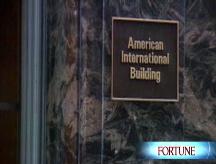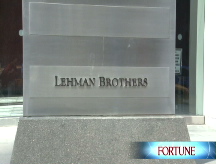AIG: Pressure mounts with downgrades
Nation's largest insurer hit by credit raters as it tries to raise cash. Fed asks Goldman and JPMorgan Chase to raise $70 billion for firm. Shares end down 61%.
NEW YORK (CNNMoney.com) -- The pressure on American International Group reached fevered pitch on Monday night as the troubled insurer was hit by a series of credit rating downgrades.
The cuts could prove deadly to AIG, the nation's largest insurance company, which is scrambling to raise much-needed capital.
Late Monday night, Moody's Investors Service and Standard & Poor's Ratings Services each said they had lowered their ratings.
A few hours earlier, Fitch Rating had also downgraded AIG, saying the company's ability to raise cash is "extremely limited" because of its plummeting stock price, widening yields on its debt, and difficult capital market conditions.
The downgrades will make it more expensive for AIG to issue debt and harder for it to regain the confidence of investors.
Fitch said AIG could be required to post $10.5 billion of additional collateral if it was downgraded one notch by one of the other major rating agencies and $13.3 billion of collateral if downgraded by both, Fitch said in a statement, citing AIG's July 31 estimates.
The grim assessments came after a day in which state and federal officials raced to help the insurer gain access to much needed cash.
The company has lost more than $18 billion in the past nine months.
The credit downgrades could doom its business.
AIG did not immediately reply to a request for comment on the late-night downgrades.
New York State gave AIG, the nation's largest insurer, the power to transfer $20 billion in assets from its subsidiaries to use as collateral for daily operations, said Gov. David Paterson. In exchange, the parent company will give the subsidiaries less-liquid assets.
"It is simply giving AIG (AIG, Fortune 500) in effect the ability to provide a bridge loan to itself," said Paterson, stressing the company is financially sound and that no taxpayer dollars are involved.
Meanwhile, the Federal Reserve asked Goldman Sachs (GS, Fortune 500) and JPMorgan Chase (JPM, Fortune 500) to make $70 billion to $75 billion in loans available to AIG, the Wall Street Journal reported.
However, any discussions are very preliminary, a source close to the matter told CNNMoney.com.
Also, the Fed has hired Morgan Stanley (MS, Fortune 500) to examine alternatives for AIG and determine whether the government should help the insurer, a source said.
JPMorgan and the Fed declined to comment, while Goldman and Morgan Stanley did not immediately return requests for comment.
Wall Street had expected AIG to issue a restructuring plan that would address its capital crunch and boost investor confidence. But the company, a component of the benchmark Dow Jones industrial average, remained silent.
Investors punished the stock, sending it down 61% to close at $4.76 Monday. The company, which has been rocked by the subprime crisis, has seen its stock price fall more than 91% so far this year.
The New York Times reported late Sunday night that the company is seeking a $40 billion bridge loan from the Federal Reserve. A source close to the firm said that if AIG does not raise cash and is downgraded by ratings agencies, it may have only 48 to 72 hours to survive.
The restructuring plan was expected to include the sale of assets, including its annuities unit and its domestic auto insurance business, the Journal reported Sunday. It may also look to dispose of its aircraft-leasing arm, International Lease Finance Corp., which has a fleet of more than 900 airplanes valued at more than $50 billion.
AIG spokesman Nicholas Ashooh told CNNMoney.com on Monday that the company is "still evaluating alternatives."
The ailing company, which had planned to announce a turnaround strategy on Sept. 25, is being forced to accelerate the announcement after investors fled the stock last week.
The company is likely to sell its personal insurance and annuities businesses and the aircraft leasing unit, wrote Joshua Shanker, a Citigroup analyst, who believes the company might have to mark down another $30 billion in assets.
"We believe AIG will survive, but we have little indication of how many business lines will ultimately need to be sold and how dilutive to shareholders future capital raising efforts will be," Shanker wrote.
AIG, which already raised $20 billion in fresh capital earlier this year, has been pummeled by three quarters of huge losses and writedowns.
Its troubles stem from its sales of credit default swaps - insurance-like contracts that guarantee against a company defaulting on its debt - and from its subprime mortgage-backed securities holdings.
AIG has written down the value of the credit default swaps by $14.7 billion, pretax, in the first two quarters of this year, and has had to write down the value of its mortgage-backed securities as the housing market soured.
The insurer could be forced to immediately come up with $18 billion to support its credit swap business if its ratings fall by as little as one notch, wrote John Hall, an analyst at Wachovia.
But the company has many attractive businesses it could sell to raise capital, he said.
"We think investors need to divorce themselves of the notion that the AIG which emerges from these problems will resemble the insurance titan of the past," Hall wrote.
This year's results have also included $12.2 billion in pretax writedowns, primarily because of "severe, rapid declines" in certain mortgage-backed securities and other investments.
What happens to AIG now depends on its ability to sell assets and to unleash the assets in its subsidiaries, Fitch said.
AIG has struggled all year as the Wall Street credit crunch took its toll.
In June, the company tossed out its chief executive, Martin Sullivan, who had been charged with turning the company around after directors removed longtime CEO Hank Greenberg in 2005. Greenberg was the target of one of then-Attorney General Eliot Spitzer's investigations.
The board named AIG chairman Robert Willumstad, who joined AIG in 2006 after serving as president and chief operating officer of Citigroup (C, Fortune 500), to replace Sullivan as chief executive officer.
Though AIG's problems have been apparent for months, it is coming under fire now because of Wall Street's increasing skittishness over Lehman Brothers, also a big player in credit default swaps, said Chip MacDonald, partner in the capital markets group at Jones Day, a law firm.
"It's the lack of transparency and clarity about their business," MacDonald said. "In today's environment, everyone is assuming the worst so they are forcing AIG to come out with a plan sooner rather than later."
However, MacDonald noted, AIG is not in as vulnerable a position as other financial institutions because of its core insurance business. Customers cannot simply withdraw their deposits, as they can at a bank.
"It's a little harder to make a run on an insurance company," MacDonald said. ![]()




